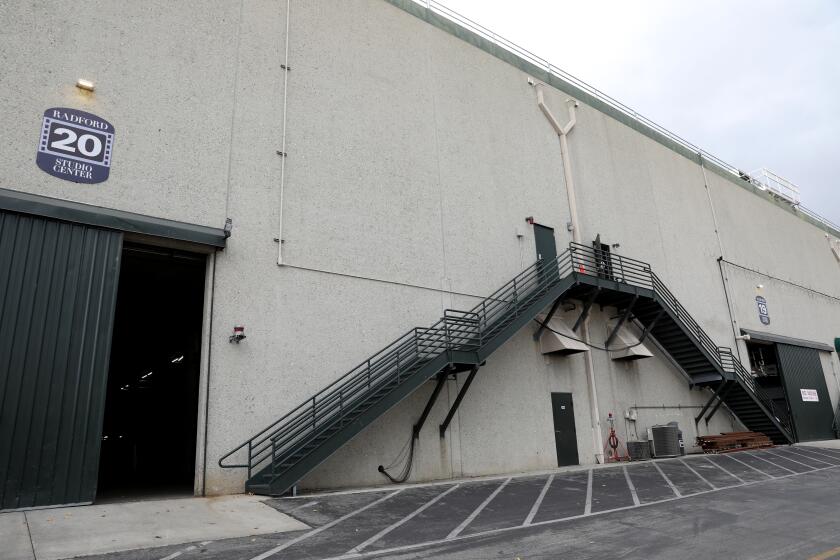REGIONAL REPORT : Export Boom Softens Blow of Recession : Trade: Southland companies are enjoying the foreign demand for U.S. goods and the relative weakness of the dollar.
When Kal Kan Foods began seriously courting the pets of Japan in 1987, the Japanese product manager for the Vernon pet food maker advised slicing the meat in its Pedigree dog food into more uniform-sized chunks.
“In explaining why we needed such perfectly cut little pieces, he said people were picking it up piece by piece and feeding their dogs with chopsticks,” said John Murray, Kal Kan’s vice president of marketing and sales. The tactic must have helped because Pedigree is now the best-selling brand of food for Japan’s 7 million dogs, Murray said.
Kal Kan is not alone in its exporting success. In fact, Southern California is riding an export boom that has shielded many companies from the worst of the recession.
Nationwide, the foreign trade deficit in March shrank to its smallest level in almost eight years as exports grew and imports dropped. Economists fingered the recession as the culprit for the $1.1-billion decline in purchases of imported goods.
The Bush Administration is hoping that export expansion will help yank the nation from its economic mire, with Commerce Secretary Robert A. Mosbacher calling exports “the engine of growth for the American economy.” The strongest export growth in March came from capital goods, manufactured goods and high-technology products.
Export experts note that Southern California is uniquely situated to benefit from a national export explosion that is driven by foreign demand for U.S. goods and the relative weakness of the dollar. Indeed, “the Gateway to the Pacific Rim” as a description of the Southland has become something of a cliche even among the area’s biggest boosters.
“Los Angeles is a major center of the Pacific Rim,” said Merry Tuten, president of the Greater Los Angeles World Trade Center Assn. “However, our trade with Canada, Mexico and Europe also has major impacts on our local economy.”
Los Angeles is the fastest-growing international trade region in the nation, with imports and exports last year through the Los Angeles Customs District totaling $106.7 billion, up 5%. That amounted to 8% of the U.S. trade total and was second only to New York, she said. (At California’s two other customs districts, $7.8 billion passed through San Diego and $51.3 billion passed through San Francisco/Oakland.)
Exports from the Southern California aerospace industry grew the fastest in total dollars, up $650 million, or 16.5%, to $4.6 billion. Other big export gainers locally were autos and auto parts and a category including computers, components, electronics, radios and telecommunications equipment, according to TradeWatch, a Los Angeles research firm.
“There is a growing world requirement for aircraft, and we’re seeing that growth most in the Pacific area,” said Don Hanson, spokesman for Long Beach-based Douglas Aircraft Co. “Historically we’ve built roughly half of the airplanes we deliver for customers outside the U.S. . . . and a major part of our business is the continuing support of those airplanes’ delivery.”
The overall growth has continued in 1991. Preliminary data suggests that exports from the Los Angeles Customs District rose about 10% in the first three months of the year, said Jack Kyser, chief economist for the nonprofit Economic Development Corp. of Los Angeles County.
“Export volume is actually doing fairly well” despite the recession, he said. Short-term growth in exports could slow, Kyser added, if the dollar strengthens and the economies of Japan, Germany and the United Kingdom soften.
But international trade--imports, exports and the service businesses that have sprung up around them--”is the thing that will carry the region in the ‘90s,” said Stephen Levy, director of the Center for Continuing Study of the California Economy. “We believe that it is real and it will be a very positive part of the region’s growth.”
A clear indication of the rising interest in international trade is the number of people and companies joining the World Trade Center Assn. of Orange County, that county’s largest trade group, said Vice President Christine Axelson.
Since 1989, membership has jumped 40% to 950. “We found a continuous stream of new, small- and medium-sized companies turning to us for assistance in exploring new markets abroad,” she said.
Southwest Marine took its maiden voyage into international trade last year because the San Diego company’s executives realized that repair orders for U.S. Navy ships--the company’s main business--will fall dramatically as the Defense Department reduces the size of the nation’s military fleet.
So, in searching for civilian business to make up the difference, Southwest President Art Engel took a big risk when he fought government-subsidized shipyards in foreign countries for a chunk of the lucrative cruise ship refurbishing business.
Southwest surprised industry observers by winning a $75-million cruise ship refurbishing job on the Viking Princess, which in June will return to service out of the Port of Los Angeles. Southwest wasn’t the lowest bidder, but it managed to snatch the contract out of the hands of Far East and German shipyards that have dominated the industry for more than 30 years.
Engel believes that the Viking Princess contract is Southwest’s chance to “prove to the world” that its yard is competitive with the Asian and European operations that control the market for extensive cruise ship refurbishing contracts.
At Los Angeles-based Harden Industries, which makes high-end brass plumbing fixtures and bathroom accessories, exports are the fastest-growing component of the 9-year-old company’s business, said President Barbara Rodstein.
“We’re doing very very well with that,” particularly in Japan because companies are being pressured by their government to buy from the United States, she said.
Small companies such as Satellite Technology Management Inc. in Costa Mesa are benefiting from foreign nations’ desire to improve communications systems at the same time that the U. S. government is changing export regulations.
“The primary reason why the overseas market is growing for us is because of the weak infrastructure in many developing countries,” according to Steve A. Strohman, the company’s senior vice president.
Last year, exports contributed 85%, or $15 million, to Satellite Technology’s total revenue.
Eastern Europe is particularly important, Strohman said, because of government moves to privatize telecommunication entities. Just last week, the company was awarded a $3.1-million contract to supply satellite equipment to Germany’s postal, telegraph and telephone agency. The German government agency is in the midst of merging its operations with comparable services in what was East Germany.
Small and minority-owned businesses, often undercapitalized to begin with, tend to have a difficult time playing the export game.
But, Gerald Kahl, vice president of El Cajon-based Kahl Scientific Instrument Corp., said there is no secret to turning a profit in the international market. Indeed the small company, founded by Kahl’s father, Joseph, in 1935, is a giant when it comes to foreign trade.
Kahl, with 25 employees and $1.5 million in annual revenue, is the only firm in San Diego County to earn an “E Star” award from the U.S. Department of Commerce, which annually recognizes “continued superior performance” by export-minded companies.
Kahl’s export expertise is not new. The family-owned firm won its award nearly a decade ago, and exports of the equipment that scientists use to make chemical, biological and physical measurements account for 75% of Kahl’s revenue.
“The same business principles apply overseas as here,” Kahl said. “There are certain variations . . . but you need to know what you want to sell and what the possibilities are of selling it. Know what kind of customer to expect in a given area, and do whatever is necessary to sell your product.”
Contributing to this story were Times staff writers Cristina Lee in Orange County and Greg Johnson in San Diego.
Southland Goes to Market Growth of imports and exports through the Los Angeles Customs District, which includes the ports of Los Angeles, Long Beach, Hueneme, Los Angeles International Airport and an oilfacility in El Segundo. Top Trading Partners The biggest players in international trade-imports and exports-through the Los Angeles Customs District in 1990.Source: Commerce Department
More to Read
Inside the business of entertainment
The Wide Shot brings you news, analysis and insights on everything from streaming wars to production — and what it all means for the future.
You may occasionally receive promotional content from the Los Angeles Times.






